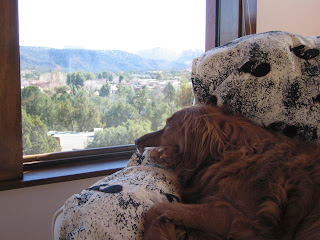 Many people have been asking me to start writing here again, so I decided it was time to fill you in on some of my news. You may remember the special lookout Mum cut for me in the fence on the porch...I loved sticking my head through there and watching all the goings on out on the street.
Many people have been asking me to start writing here again, so I decided it was time to fill you in on some of my news. You may remember the special lookout Mum cut for me in the fence on the porch...I loved sticking my head through there and watching all the goings on out on the street.
When we moved to our new house, I was very disappointed to find out that there was no front porch, but then I discovered something MUCH better. There are two of these outside places and I can stick my head between the metal sticks any place I want. I can see the whole street and much further too, as we're way up high above the trees.

When it's wet, I can watch everything from the living room windows without ever getting up from my chair. There are windows all over and I don't even have to stand on anything to look out.
I think this house must have been designed by a dog.

3 comments:
I think it's unlikely that your dog is an Irish setter/golden mix. In fact, she looks like a field-line golden. Irish setters are comparatively uncommon, and those that do exist typically aren't allowed to cross with goldens.
Field line goldens and the original golden retrievers that were recognized as distinct from the flat-coat were quite dark in color and very setter-like.
The second dog from the right is an early show champion golden in the 1930's-- Ch. Noranby Diana.
http://retrieverman.files.wordpress.com/2008/11/noranby-diana.jpg
The person who was most responsible in getting the golden recognized as distinct breed was Winifred Charlesworth-- the breeder of two dark dog in that photo. She also wrote the first standard for the breed.
In Britain, light-colored dogs have become much more common. Cream-color was added to the breed standard in the revision of 1936, and by the 1960's, the breed in Europe shifted from dark gold to almost white in color. The dogs got much more bone.
It's only been in recent decades that goldens in the US have begun to change. They have gotten more feathering, heavier bone, and lighter colored. Some are quite large.
However, working-bred goldens typically retain this lighter body with darker coat color. They do look like setter crosses and are often mistaken for them.
That's because goldens originally were culls from wavy-coated (flat-coated) retriever litters that had been interbred with Irish setters. The 1st Baron Tweedmouth founded a line off of these culls, using "red setters" as an important outcross to his line.
The breed was originally considered a "liver flat-coat" by the Kennel Club, and then as a "flat coats (yellow)" in 1908. In 1911, a separate standard was written for them, and in 1912, they yellow or reddish dogs were separated from the flat-coat breed. However, the separation was not total, because flat-coats sometimes have yellow puppies.
One of the top "flat-coats" in retriever trials in the early 1900's was Don of Gerwn. Don's mother was a liver flat-coat named Rust (rusty chestnut liver) and his father was Lucifer (a gold dog from the 1st Baron Tweedmouth's line). So the two breeds are quite closely related.
Because your dog is a rescue, please at least consider that your dog is a pure, working-line golden.
And check out my blog, which has lots of information on them: http://retrieverman.wordpress.com/
Thanks for your informative comments. It's not really important to us what breed of dog Ruby is. The Irish Setter component was advised more because of her behavior than her looks. Although she does have some distinctly golden retriever behavioral characteristics, as a puppy she was super-energized, highly excitable and had difficulty focusing during training. 8 mile daily hikes (runs for her) were a necessity, with hours of playing, running and chasing in between. We believe her hyper-activity was the main reason she was in a shelter for so long, and why she was returned after 2 weeks with someone. I was on the verge of giving up myself many times during the early days as I was so exhausted. But I persisted through training programs, dog behaviorists and Tellington Touch (this had the most dramatic and immediate effects). Everyone told us she would start calming down after 2 years old. She was at least 5 before there was any noticeable difference. She's 9 now and still behaves like a much younger dog.
Ruby does have a white blaze on her chest and a white flash between the shoulders, which is another reason we were given for her not being purebred golden.
At the end of the day, none of it really matters. She has a wonderful personality and brings much joy to everyone she meets.
Well, high energy and occasional attention deficits are characteristic of some field line goldens.
They are all technically setter crosses.
The breed is derived from a dog called a wavy-coated retriever, which was a cross between the ancestral Labrador-type retriever from Newfoundland (St. John's water dog) and some strain of setter. Very often, that strain was an Irish setter or a red Gordon (which are quite rare and faulty today). Because red is recessive to black, which was the main color of the ancestral Labrador-type, it was not unusual to get reds puppies in retriever litters. Golden retrievers are derived from as strain of wavy-coat that were selected from these red culls. This happened on a Scottish estate in the Highlands.
Originally the very dark colors were preferred. The lighter colors that we now like in the show ring were quite uncommon, and they most likely don't come from the setter influence but from an extinct water spaniel (Tweed water spaniel) that was used in the strain.
As late as ten years ago, you could find goldens that were very dark and approached a mahogany color in this country. These were quite common in the working strains. Indeed, the first Dual Champion golden retriever was a very dark mahogany.
Because Irish setters are nowhere near as popular as they once were, I think that many golden retrievers are being misidentified as crosses. And the wild behavior is de rigueur for making working strain retrievers, not just goldens.
Post a Comment